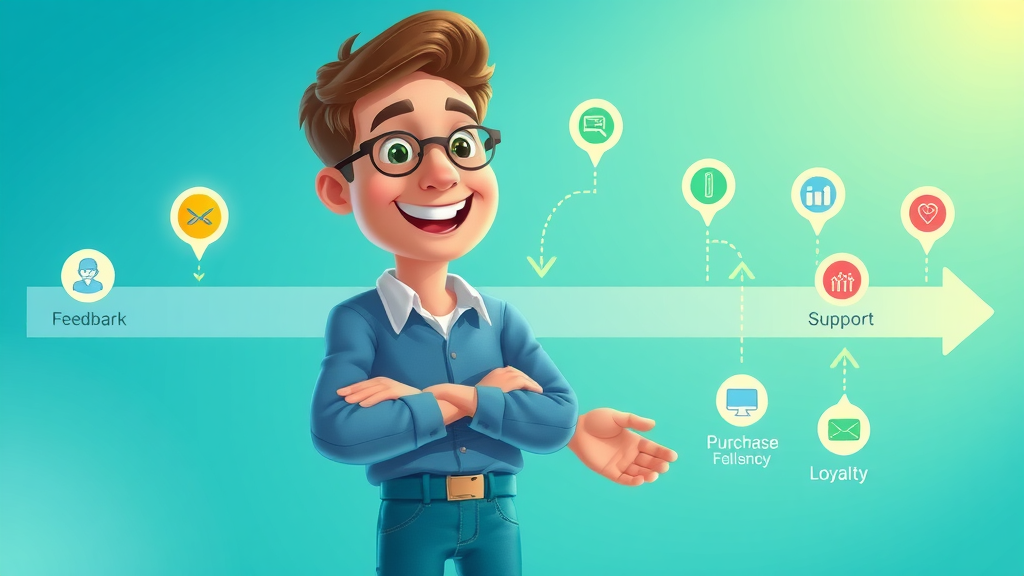Did you know that a staggering 86% of buyers are willing to pay more for a better experience? In a competitive market where products and prices are becoming more alike, customer experience optimization is the true game changer. Brands that prioritize each customer interaction—not just the sale—are the ones who transform occasional buyers into loyal advocates. If you’re ready to master the science (and art!) of optimizing the customer experience, this comprehensive guide is packed with practical tips, real examples, and the essential metrics you need to win lifelong customers.

Why Customer Experience Optimization Is the New Battleground for Brands
- Discover how an astonishing 86% of buyers will pay more for a better customer experience — a statistic that proves customer experience optimization isn't just an advantage, it's a requirement for survival.
The landscape of customer experience optimization is not only growing—it's evolving at lightning speed. Modern consumers expect seamless, personalized journeys at every customer touchpoint, putting intense pressure on brands to go beyond basic satisfaction. It’s no longer enough to simply deliver on your product or service; every interaction, from website browsing to social media engagement and customer support, must leave a positive impression. Businesses that invest in robust experience optimization consistently outperform competitors and report higher customer loyalty.
Why has customer experience become the battleground for brands? Simply put, the best brands understand that optimizing the customer journey drives up customer satisfaction, fosters emotional connections, and increases the likelihood of loyal customers. Recent studies show that the ripple effect of a positive experience is far-reaching—satisfied customers not only return, but they become advocates, helping you attract new business via word-of-mouth and glowing online reviews.
Core Elements of Customer Experience Optimization
- customer experience
- experience optimization
- customer journey
- customer feedback
- customer satisfaction
- customer loyalty
Defining Customer Experience Optimization and Its Business Impact

Customer experience optimization is the strategic process of continually adapting, refining, and improving every phase of the customer journey. This approach isn’t about isolated gestures—it’s about a holistic commitment to exceeding consumer expectations at every interaction. By mapping out all possible customer touchpoints and systematically addressing pain points, brands can identify areas that need improvement and transform ordinary transactions into memorable occasions.
The business impact of focusing on experience optimization is profound. Brands that champion excellent customer experience see faster growth, stronger customer loyalty, and increased customer lifetime value. Through targeted actions like collecting customer feedback , investing in innovative digital platforms, and training frontline staff, you can make your company more resilient in the face of shifting consumer demands. Remember, every improvement to the customer journey directly benefits your bottom line by increasing retention and fostering loyalty.
As a practical example, consider a retailer that leverages a customer journey map to monitor each interaction, from browsing products online to the post-purchase follow-up. By proactively addressing negative pain points, offering timely assistance via a contact center, and personalizing the shopping experience, the retailer witnesses a marked rise in customer satisfaction and repeat purchases—a clear business benefit of customer experience optimization.
The Relationship Between Customer Experience and Customer Loyalty
There’s a direct connection between customer experience optimization and building a base of loyal customers. Not only do loyal customers make more frequent purchases, but they also show a higher tolerance for occasional mistakes and are less likely to switch to competitors. By consistently providing positive experiences, you develop trust and foster a sense of emotional investment in your brand.
This loyalty is not just measured by repeat transactions; it’s visible in customer advocacy across channels like social media , where referrals and recommendations drive new growth. The best brands recognize that positive customer interactions at every stage—from initial inquiry to customer support—translate into higher retention rates and robust word-of-mouth marketing. In short, investing in optimizing customer experience creates a virtuous cycle that grows your business sustainably.
Moreover, customer loyalty acts as a buffer against market disruptions. When your company prioritizes experience optimization, you create deep-rooted relationships that withstand competitive pressures. As your customer base evolves into a community of loyal advocates, you’re not only safeguarding revenue but also amplifying your market influence through lasting connections.
Customer Satisfaction: The Foundation of Experience Optimization
At the core of any successful experience optimization strategy lies customer satisfaction. Ensuring that customers feel valued at every touchpoint is fundamental to fostering strong relationships. Satisfied customers are more likely to become repeat buyers and act as brand ambassadors, fueling your growth organically.
Measuring customer satisfaction relies on a combination of qualitative and quantitative feedback—including surveys, support interactions, and social media sentiment analysis. By listening to what customers are saying, you can identify areas for improvement and deliver a personalized experience that meets anticipated and unanticipated needs.
Focusing on customer satisfaction benefits not just your reputation, but also your bottom line . Companies with higher satisfaction scores enjoy lower customer churn, increased customer lifetime value, and more engaged employees. Remember, satisfied customers become the foundation of all other experience optimization outcomes, setting the stage for loyalty and advocacy.
| Aspect | Traditional Customer Experience | Optimized Customer Experience |
|---|---|---|
| Customer Support | Reactive, generic responses | Proactive, personalized assistance across all channels |
| Customer Feedback | Sporadic collection, little action | Continuous collection, actionable improvements implemented |
| Customer Journey | Fragmented, inconsistent touchpoints | Mapped touchpoints, seamless transitions, minimized pain points |
| Customer Loyalty | Transactional relationships | Emotional connections, higher customer retention |
| Business Outcomes | Minimal growth, high churn rate | Increased CLV, referrals, and competitive advantage |
Understanding the Customer Journey: The First Step in Customer Experience Optimization

Before you can optimize the experience, you must understand every step a customer takes with your brand. Mapping the customer journey exposes hidden inefficiencies and uncovers new opportunities for delight. When teams come together to analyze a customer journey map , they identify critical touchpoints—from website navigation and checkout to after-sales support—where customer expectations are made or broken.
The process of mapping your customer journey requires you to walk in your customer’s shoes, capturing every interaction through their eyes. By visualizing journeys with digital charts or interactive diagrams, you can pinpoint moments of confusion, frustration, or delight. This data-driven approach ensures that your efforts to optimize the customer experience are grounded in reality, not assumptions.
Ultimately, understanding the customer journey is about recognizing that every moment matters. Whether a customer is reaching out to your contact center, engaging with your social media, or browsing your site on mobile, these interactions shape their perception of your brand and influence their future choices.
Mapping the Customer Journey: How to Identify Critical Customer Touchpoints
Creating a comprehensive customer journey map is a cornerstone of successful customer experience optimization. Begin by identifying all the ways customers interact with your brand—from social media ads and website visits to in-store purchases and post-purchase emails. These are your critical customer touchpoints , and optimizing each one is key to a seamless experience.
To effectively identify these touchpoints, gather customer feedback through surveys, direct interviews, and analysis of support tickets. Look for trends or recurring pain points that indicate a need for improvement. For example, if many customers cite confusion during the checkout process, that’s a clear priority for experience optimization.
As you build your journey map , consider involving all departments—marketing, sales, customer service, IT—to get a 360-degree view of the experience. The more accurately you can identify and document each customer interaction, the more targeted (and effective) your optimization efforts will be.
Using Journey Maps to Pinpoint Pain Points and Gaps
A well-crafted customer journey map does more than chart the path from awareness to purchase—it highlights the friction that customers encounter along the way. Common pain points include slow website loading times, a lack of proactive customer support, or disjointed handoffs between sales and service teams.
By overlaying customer feedback onto journey maps, you can quickly see where expectations are not being met. For instance, frequent complaints about order tracking updates suggest a gap in your post-purchase touchpoint. Addressing these pain points promptly not only increases customer satisfaction but also minimizes the risk of negative reviews or customer churn.
The process is iterative—each time you gather new data or introduce a new service, revisit your journey map. Continually updating the customer journey map ensures your experience optimization strategy remains relevant as customer preferences evolve and new channels emerge.
Video: Real-World Example of Journey Mapping for Customer Experience Optimization
Watch a real-life team in action as they map out a customer’s path from initial inquiry to post-purchase support. See how identifying and addressing key touchpoints can transform service delivery, improve loyalty, and turn friction into delight through true customer experience optimization.
Designing for Customer Experience Optimization: Strategies and Best Practices

To achieve remarkable customer experience optimization , brands must design interactions that feel effortless and genuinely personalized. The following strategies blend technology, empathy, and creativity to set your company apart. By leveraging the latest tools and fostering a culture of innovation, you can consistently deliver memorable experiences that drive lasting loyalty.
Start by making feedback collection frictionless and actionable. Implement omnichannel support systems where customers can connect with you via chat, email, or social media—whichever is most convenient for them. Next, explore automation and self-service portals to resolve common issues quickly. For more complex situations, train your team to deliver genuinely helpful and personalized support.
Ultimately, the brands that lead in experience optimization align every part of their business—from product design and marketing to customer support—around customer needs. This creates a unified experience that sets you apart from competitors who fail to connect the dots between digital innovation and human touch.
Leveraging Customer Feedback for Continuous Experience Optimization
The most valuable insights for experience optimization come directly from your customers. By adopting a proactive approach to customer feedback , you gather real-time information about what’s working and what needs attention. Tools like web surveys, reviews, and social listening platforms allow you to collect and categorize feedback across every stage of the customer journey.
What sets top brands apart is their ability to act on this feedback quickly. By analyzing customer data, you can identify chronic pain points or emerging trends and respond with targeted improvements. Consistent feedback loops ensure you’re optimizing the customer experience continuously, not just reacting to problems as they arise.
Involving your frontline staff in this process fosters accountability and accelerates innovation. When employees feel empowered to share customer insights and test new solutions, you build a culture that values customer satisfaction and evolves with changing consumer expectations.
Personalizing Customer Interactions to Drive Customer Satisfaction
Modern consumers crave personalization. Whether it’s a tailored email, customized product recommendations, or timely outreach based on prior behavior, personalized experience is a central pillar of customer experience optimization . By collecting and utilizing customer data , companies can deliver relevant interactions that feel meaningful, not generic.
Personalization goes beyond first names in emails. It can include remembering customer preferences, anticipating needs based on previous purchases, or sending proactive updates about relevant offers or support. The goal is to make every customer interaction feel unique, valued, and effortless.
When customers notice this attention to detail, their satisfaction and loyalty increase dramatically. As a result, brands that consistently offer personalized experiences achieve stronger customer relationships and longer customer lifetime value.
"Every interaction is an opportunity to elevate your brand’s reputation. Customer experience optimization transforms these moments into lasting loyalty."
Key Customer Touchpoints to Optimize for a Seamless Customer Journey
- Website navigation
- Checkout process
- Customer support
- Post-purchase follow-up

Prioritize optimizing these critical customer touchpoints to create an unbroken, positive experience. A well-designed website ensures customers can find what they’re looking for without frustration. Streamlining the checkout process minimizes the risk of abandoned carts and lost revenue.
Equally important, proactive customer support—be it live chat, self-service, or a responsive contact center—addresses questions and concerns before they become pain points. Finally, thoughtful post-purchase communication (such as order updates, thank-you messages, or satisfaction surveys) keeps customers engaged and signals that their experience matters, even after the sale is complete.
Focusing on these touchpoints closes the loop of the customer journey and makes customers feel supported and valued at every step.
Video: How to Optimize Your Digital Customer Touchpoints
Watch this action-packed tutorial on transforming digital customer touchpoints. Discover design tips and process enhancements that ensure each online interaction is seamless, personalized, and primed for maximum customer satisfaction.
Harnessing the Power of Customer Data in Customer Experience Optimization
Collecting and Analyzing Customer Data for Experience Optimization

The foundation of advanced customer experience optimization lies in customer data . From purchase histories and website behavior to support inquiries and social media activity, data offers invaluable insights into what customers want, how they behave, and where their needs are not being met.
Start by implementing robust systems to gather data across all platforms—website analytics, CRM tools, chat transcripts, and feedback forms. Analyze this data for recurring themes, emerging pain points, and key customer preferences. Data-driven experience optimization means decisions are based on actual behaviors and outcomes, rather than assumptions or outdated practices.
Remember, a respectful approach to data is crucial. Clearly communicate data usage policies and leverage insights to improve—not just personalize—the customer experience, without being intrusive or compromising trust.
Data-Driven Personalization: Enhancing Customer Interactions
Smart brands turn data into action through real-time, data-driven personalization. This means leveraging purchase history, browsing habits, and support requests to craft offers, recommendations, and communications that truly resonate with each individual customer. The result is a highly relevant, personalized experience that can dramatically boost engagement and conversion rates.
For example, an e-commerce brand might use customer data to recommend complementary products at checkout. Or a telecom provider could automatically reach out to customers near the end of their contracts with tailored renewal offers. By using predictive analytics, you can even anticipate customer needs before they're expressed, removing roadblocks and turning ordinary interactions into opportunities for delight.
Ultimately, data-driven personalization not only satisfies today’s customers but positions your brand as a proactive, customer-centric leader in experience optimization.
| Data Type | Example | Impact on Experience Optimization |
|---|---|---|
| Demographic Data | Age, gender, location | Customization of content, relevant offers |
| Behavioral Data | Website clicks, purchase history | Personalized recommendations, targeted messaging |
| Transaction Data | Order frequency, spend amount | Identifying high-value customers, loyalty programs |
| Feedback & Sentiment | Survey responses, reviews, social mentions | Spotting pain points, guiding improvements |
| Support Interactions | Chat logs, email tickets | Proactive support, process streamlining |
Building a Culture of Customer Service Excellence
The Role of Employee Training in Customer Experience Optimization

No customer experience optimization strategy succeeds without well-trained, empowered employees. Investing in comprehensive customer service and support training ensures staff have the knowledge and skills to handle any situation with empathy, efficiency, and confidence. This translates directly into more satisfying customer interactions and fewer unresolved pain points.
Effective training programs go beyond problem solving; they instill a customer-centric mindset and encourage team members to seek continuous improvement. Practical exercises such as role-play, real-time feedback, and exposure to customer journey maps give employees insight into every customer touchpoint and the impact their actions have on customer satisfaction.
When employees are fully engaged in the experience optimization process, they become ambassadors for your brand values and champions of customer loyalty.
Customer Support as a Strategic Differentiator
In crowded markets, exceptional customer support is one of the fastest ways to stand out. By shifting from a cost-center mindset to viewing customer service as a strategic function, you create opportunities to build trust and win loyalty with every interaction. Fast response times, knowledgeable representatives, and empowered problem-solving leave customers feeling valued and respected.
Companies that consistently deliver outstanding support not only resolve issues faster but also transform negative experiences into positive outcomes. Over time, they build relationships that weather market changes and drive strong customer lifetime value. Remember, every support ticket is a chance to reinforce your commitment to customer satisfaction and demonstrate your unique value proposition.
Excellent customer support is an investment in your reputation—and in your bottom line.
"Companies that excel at customer service and experience optimization grow revenues 4-8% above their market."
Aligning Company Values with Customer-Centricity
True customer experience optimization requires a cultural commitment to putting the customer first. This means aligning every team, process, and decision around delivering value for the customer—not just maximizing internal efficiency or short-term profit.
Start by articulating clear company values centered on respect, empathy, and responsiveness. Ensure leadership models these behaviors and recognizes employees who champion customer-centric practices. By embedding customer focus into daily operations and decision-making, you set the stage for ongoing innovation and market leadership.
Over time, a strong customer-centric culture becomes a self-reinforcing engine for growth—fueling loyalty, advocacy, and higher customer retention rates.
Customer Experience Optimization in Action: Case Studies and Success Stories

Case Study 1: A Retailer’s Transformation through Journey Map Adoption
One major retailer faced slipping customer satisfaction scores and falling retention. By assembling a cross-functional team to build a comprehensive customer journey map , they traced every potential customer interaction—from online search and in-store experiences to post-purchase follow-up. The process revealed gaps and pain points, especially in the handoff between digital and physical channels.
The retailer responded by streamlining website navigation, training sales associates in proactive customer service, and implementing automated order updates. Within six months, they saw a significant increase in customer satisfaction and a 20% bump in repeat sales—clear proof that journey mapping is a cornerstone of customer experience optimization success.
This transformation highlights the business impact of seeing the experience through your customer’s eyes and rigorously optimizing every touchpoint.
Case Study 2: How Customer Feedback Drove Experience Optimization in Financial Services
A financial services firm wanted to boost loyalty and reduce customer churn in a highly regulated, competitive sector. The company launched a campaign to collect candid customer feedback via surveys and social media reviews, focusing on support quality and online services. The results pinpointed slow account updates and unclear communication as leading pain points.
By investing in digital self-service options, retraining support staff, and adding proactive notifications for key milestones, the firm dramatically improved both customer satisfaction and retention. Over a year, customer complaints dropped by 35%, while positive reviews and referrals increased, driving sustainable growth among loyal customers.
This case underscores how a disciplined focus on customer feedback and experience optimization builds robust, long-term relationships.
Video: Customer Loyalty Boosted through Innovative Customer Experience Optimization
See how an innovative approach to customer experience optimization led to a spike in customer loyalty. Real-world interviews reveal firsthand the impact of seamless journeys and personalized experiences on customer enthusiasm and advocacy.
Metrics and KPIs to Measure Customer Experience Optimization Success
- Net Promoter Score (NPS)
- Customer Satisfaction Score (CSAT)
- Customer Lifetime Value (CLV)
- Customer Retention Rate
To sustain momentum in customer experience optimization , you need clear metrics. Net Promoter Score (NPS) measures how likely customers are to recommend your brand, while Customer Satisfaction Scores (CSAT) track immediate reactions to specific experiences. By monitoring Customer Lifetime Value (CLV) and retention rates, you gain long-term insight into the health of your customer relationships.
Regularly review these KPIs to identify areas for improvement and celebrate wins. Incorporating feedback into product, service, and process design ensures that you’re moving toward a truly optimized customer experience—one that delights, retains, and converts at every step.
Remember, what gets measured gets managed—let these metrics guide your ongoing experience optimization journey.
The Future of Customer Experience Optimization: Trends to Watch
- AI-driven personalization
- Predictive analytics
- Omnichannel engagement
- Proactive customer support
The field of customer experience optimization is on the cusp of dramatic change. AI-powered personalization, which tailors offers and communications in real-time, will set new benchmarks for customer relevance and convenience. Predictive analytics will enable brands to forecast customer needs and proactively address issues before they arise.
Omnichannel engagement—seamless experiences across web, mobile, social media, and physical channels—will become the norm. And as proactive customer support tools mature, customers can expect immediate resolutions and even preemptive recommendations, eliminating friction altogether.
Stay ahead of these trends by investing early in the technology, training, and partnerships that enable next-level experience optimization. The brands that adapt fastest will shape customer expectations for years to come.
Frequently Asked Questions on Customer Experience Optimization
What does optimize customer experience mean?
Answer: Optimizing customer experience refers to systematically improving every customer touchpoint and interaction to increase customer satisfaction, loyalty, and value throughout the customer journey.
What are the 5 C's of customer experience?
Answer: The 5 C’s of customer experience are Clarity, Consistency, Convenience, Communication, and Customization — pillars for sustainable customer experience optimization.
What are the 4 P's of customer experience?
Answer: The 4 P’s—People, Processes, Personalization, and Platforms—are essential for effective experience optimization.
What is experience optimization?
Answer: Experience optimization is the practice of continually refining business interactions to meet and exceed evolving customer expectations, making it an ongoing strategy for market leadership.
Take the Next Step for Superior Customer Experience Optimization
- Want more 5-star reviews and a strategy to manage them like a pro? Grab our Free Online Review Strategy Checklist and start building unstoppable trust online.
Implement these proven strategies and monitor your metrics: you'll turn every customer interaction into a competitive edge and build lasting loyalty that grows your business.
 Add Row
Add Row  Add
Add 




Write A Comment